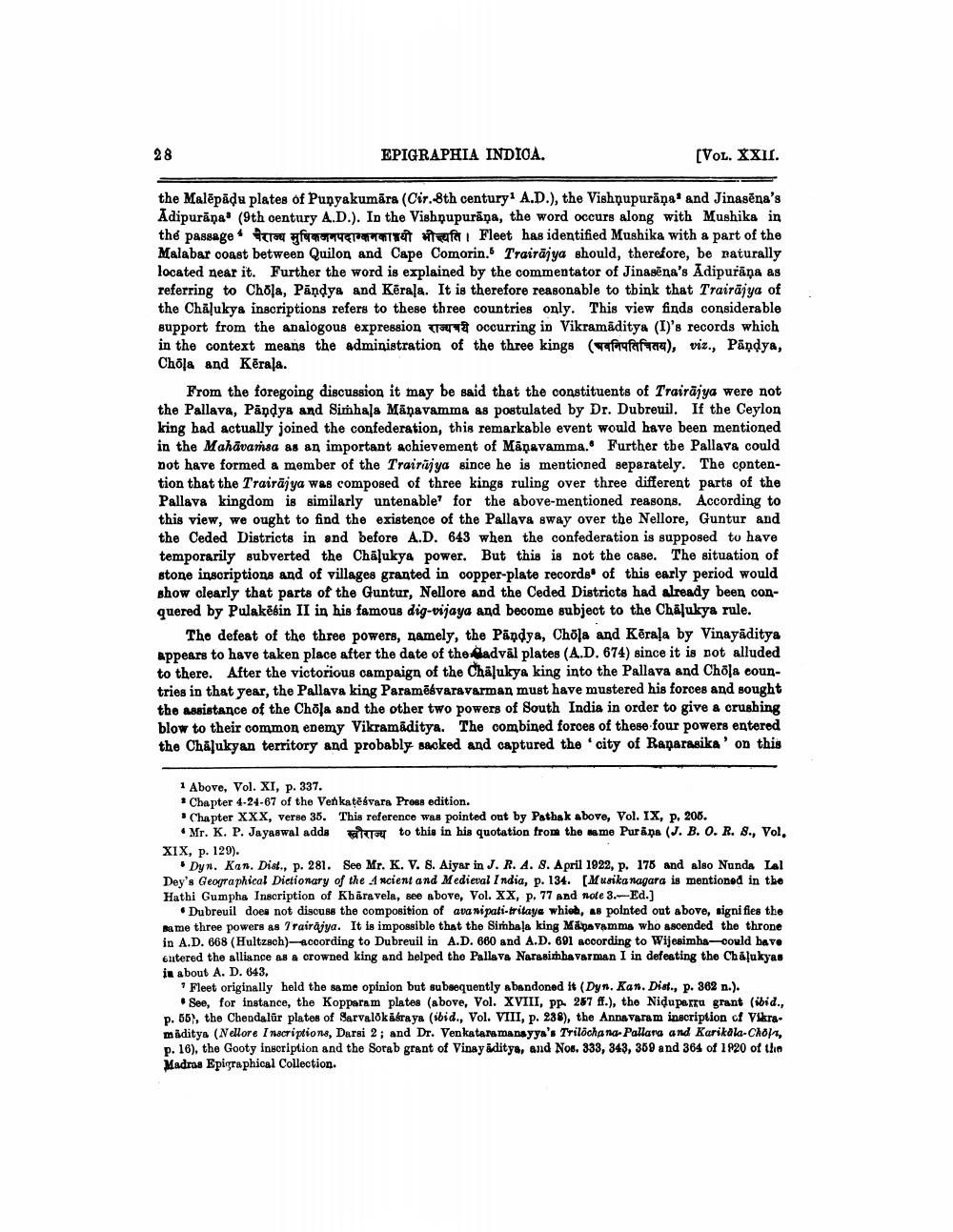________________
28
EPIGRAPHIA INDICA.
[VOL. XXII.
the Malēpādu plates of Punyakumāra (Cir.-8th century A.D.), the Vishnupurāņa' and Jinasēna's Adipuräņa (9th oentury A.D.). In the Vishnupurāņa, the word occurs along with Mushika in the passage + Atrou afum a t itafa Fleet has identified Mushika with a part of the Malabar coast between Quilon and Cape Comarin. Trairājya should, therefore, be naturally located near it. Further the word is explained by the commentator of Jinasēna's Adipurāņa as referring to Chola, Pandya and Kerala. It is therefore reasonable to think that Trairājya of the Chalukya inscriptions refers to these three countries only. This view finds considerable support from the analogous expression occurring in Vikramaditya (I)'s records which in the context means the administration of the three kings (wafafafaa), viz., Pāņdya, Chola and Kēraļa.
From the foregoing discussion it may be said that the constituents of Trairājya were not the Pallava, Pandya and Simhala Māņavamma as postulated by Dr. Dubreuil. If the Ceylon king bad actually joined the confederation, this remarkable event would have been mentioned in the Mahāvarsa as an important achievement of Māņavamma. Further the Pallava could not have formed a member of the Trairūjya since he is mentioned separately. The contention that the Trairājya was composed of three kings ruling over three different parts of the Pallava kingdom is similarly untenable? for the above-mentioned reasons. According to this view, we ought to find the existence of the Pallava sway over the Nellore, Guntur and the Ceded Districts in and before A.D. 643 when the confederation is supposed to have temporarily subverted the Chāļukya power. But this is not the case. The situation of stone inscriptions and of villages granted in copper-plate records of this early period would show clearly that parts of the Guntur, Nellore and the Ceded Districts had already been conquered by Pulakēsin II in his famous dig-vijaya and become subject to the Chālukya rule.
The defeat of the three powers, namely, the Pandya, Chola and Kērala by Vinayāditya appears to have taken place after the date of the advāl plates (A.D. 674) since it is not alluded to there. After the victorious campaign of the Chāļukya king into the Pallava and Chola coun. tries in that year, the Pallava king Paramēsvaravarman must have mustered his forces and sought the assistance of the Chola and the other two powers of South India in order to give a crushing blow to their common enemy Vikramaditya. The combined forces of these four powers entered the Chalukyan territory and probably sacked and captured the city of Ranarasika' on this
1 Above, Vol. XI, p. 337. * Chapter 4-24-67 of the Venkatēsvara Pross edition. . Chapter XXX, verse 38. This reference was pointed out by Pathak above, Vol. IX, p. 208.
. Mr. K. P. Jayaswal adda so to this in his quotation from the Mme Purina (J. B. 0. R. 8., Vol. XIX, p. 129).
Dyn. Kan. Dist., p. 281. See Mr. K. V. 8. Aiyar in J. R. A. 8. April 1922, p. 176 and also Nunda Lal Dey's Geographical Dictionary of the Ancient and Medieval India, p. 134. (Musika nagara is mentioned in the Hathi Gumpha Inscription of Khāra vela, see above, Vol. XX, p. 77 and note 3.-Ed.]
Dubreuil does not discuss the composition of avanipati-tritaya whioh, as pointed out above, signifies the
hree powers as rairäjya. It is impossible that the Simbala king Manavamma who ascended the throne in A.D. 668 (Hultzsch) coording to Dubreuil in A.D. 660 and A.D. 691 according to Wijesimha-could have entered the alliance as a crowned king and helped the Pallava Narasimha varman I in defeating the Chalukyas in about A. D. 643.
Fleet originally held the same opinion but subsequently abandoned it (Dyn. Kan. Dist., p. 362 n.).
See, for instance, the Kopparam plates (above, Vol. XVIII, PP 257 ff.), the Niduparru grant (ibid., p. 56), the Chendalūr plates of Sarvalok asraya (ibid., Vol. VIII, p. 238), the Annavaram inscription cf Vlkramåditya (Nellore Inscriptions, Darsi 2; and Dr. Venkataramanayya's Trilochana- Pallara and Karikala-Chon, p. 16), the Gooty inscription and the Sorab grant of Vinay aditya, and Nos. 333, 343, 359 and 364 of 1920 of thn Madras Epigraphical Collection.




